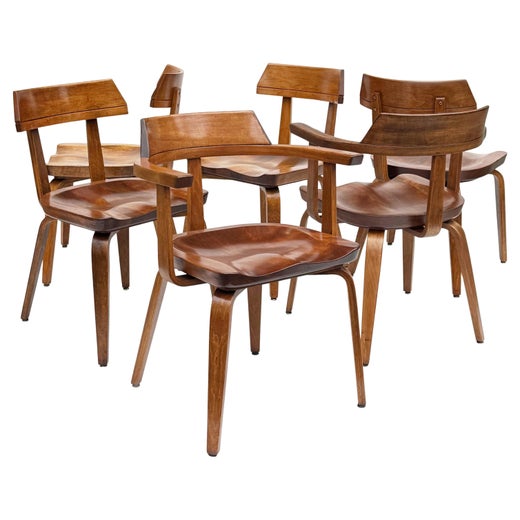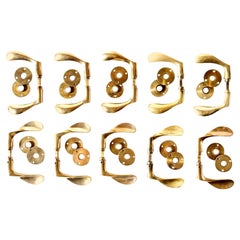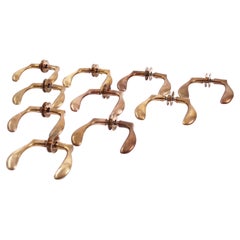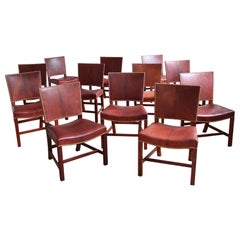Set of 14 Walter Gropius and Adolf Meyer door handles, Bauhaus ca. 1922
About the Item
- Creator:Adolf Meyer (Designer),Walter Gropius (Designer)
- Dimensions:Height: 0.75 in (1.9 cm)Width: 7.01 in (17.8 cm)Depth: 4.49 in (11.4 cm)
- Sold As:Set of 14
- Style:Bauhaus (Of the Period)
- Materials and Techniques:
- Place of Origin:
- Period:
- Date of Manufacture:1920s
- Condition:Wear consistent with age and use. Minor fading. Original with deep patina and signs og age and use. Literature Klaus Weber, Die Metallwerkstatt am Bauhaus, exh. cat., Ausstellung im Bauhaus-Archiv Museum für Gestaltung, Berlin, 1992, p. 208, fig. 168 Stefan Reinke, et al., Design: Made in German.
- Seller Location:Copenhagen, DK
- Reference Number:1stDibs: LU1541237557782
Walter Gropius
As the founder of the Bauhaus — the German art and design school that was one of the chief crucibles of modernism — Walter Gropius had a central and enduring impact on the architecture and design of the 20th century and beyond. Along with fellow Bauhaus principals such as Ludwig Mies van der Rohe and Marcel Breuer, Gropius championed a philosophy of design focused on simplicity, efficiency and the inherent beauty of steel, glass and other industrial materials.
Born in Berlin, Gropius followed in his architect father’s footsteps and after completing his studies was employed by the brilliant proto-modernist designer Peter Behrens. Gropius’s early architectural work demonstrated many of the aspects that define the modernist aesthetic: ribbon windows, an emphasis on light and minimal decoration. Gropius became known primarily as a great organizer, writer and teacher. After military service in World War I, he developed concepts of what are now called the applied arts — a marriage of creative imagination with practical skill and technology. These notions drove Gropius’s founding of the Bauhaus in 1919. The school would welcome many of the great creators of the 20th century, including Paul Klee, Laszlo Moholy-Nagy and Josef Albers. After the independent-minded college fell afoul of the Nazi regime in the 1930s, Gropius immigrated to the United States, and finished out his years on the Harvard faculty.
Gropius produced far fewer furniture designs than his fellows on the Bauhaus faculty, but what he did make has a purity of form and spirit. As you will see from the works offered on 1stDibs, Walter Gropius never compromised his vision of design that encompassed beauty, creativity and the highest level of technical skill.
You May Also Like
Vintage 1930s European Bauhaus Doors and Gates
Brass
Vintage 1930s Bauhaus Doors and Gates
Brass, Bronze
Vintage 1930s Danish Bauhaus Doors and Gates
Bronze
Vintage 1930s Scandinavian Bauhaus Doors and Gates
Metal, Brass, Bronze
Vintage 1930s Scandinavian Bauhaus Doors and Gates
Metal, Brass, Bronze
Vintage 1940s American Doors and Gates
Vintage 1970s Italian Modern Doors and Gates
Bronze
Vintage 1960s Italian Mid-Century Modern Doors and Gates
Metal
2010s Spanish Modern Abstract Sculptures
Brass
2010s Japanese Modern Doors and Gates
Stone, Iron
More From This Seller
View AllMid-20th Century Danish Mid-Century Modern Architectural Elements
Brass
Mid-20th Century Danish Mid-Century Modern Doors and Gates
Brass
Mid-20th Century European Mid-Century Modern Architectural Elements
Brass
Mid-20th Century Danish Mid-Century Modern Chairs
Leather, Mahogany
Mid-20th Century Danish Mid-Century Modern Chairs
Leather, Mahogany
Early 20th Century Art Deco Lanterns
Brass




